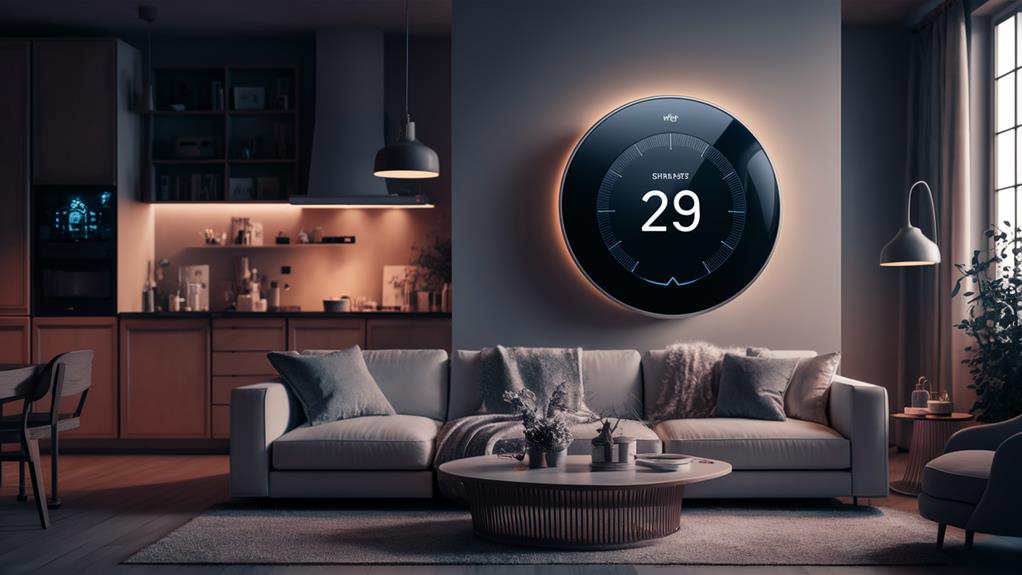For 2024, the top five smart thermostats combine energy efficiency with advanced technology. The Sensi Smart Thermostat (ST55) offers easy installation and big energy savings. Amazon's Smart Thermostat integrates seamlessly with Alexa, while the Google Nest Learning Thermostat learns your schedule for ideal comfort. If you prefer something simpler, the standard Google Nest Thermostat is an excellent choice, and the ecobee3 Lite provides compatibility with multiple voice assistants. Each comes with features that reduce energy costs considerably. Keep exploring to discover the unique benefits and installations tips for each option on this list.
Key Takeaways
- The Sensi Smart Thermostat (ST55) offers easy installation without a common wire and potential energy savings of 23% on HVAC costs.
- Amazon Smart Thermostat integrates seamlessly with Alexa and Ring, providing automatic temperature control and an estimated annual savings of $50.
- The Google Nest Learning Thermostat (3rd Generation) learns user habits to optimize temperature settings, promoting energy efficiency through its Auto-Schedule feature.
- The ecobee3 Lite Smart Thermostat supports voice control via Siri, Alexa, and Google Assistant, with potential savings of up to 23% on heating and cooling costs.
- Energy efficiency is enhanced across all models through features like geofencing, energy monitoring, and ENERGY STAR certification, ensuring effective climate control.
Sensi Smart Thermostat (ST55)

The Sensi Smart Thermostat (ST55) is perfect for homeowners looking to enhance their energy efficiency without the hassle of complex installations. Weighing just 13.6 ounces and measuring 5.88 inches wide, it fits seamlessly into any home. With easy DIY installation, you won't need a common wire, making setup a breeze. This Wi-Fi-enabled thermostat connects to most HVAC systems, offering features like geofencing and humidity control. You can manage it via a user-friendly mobile app, which allows for real-time temperature adjustments and usage reports. Plus, being ENERGY STAR certified, it can help you save about 23% on your HVAC energy costs. With a three-year warranty, you'll have peace of mind while optimizing your home's comfort and efficiency.
Best For: Homeowners seeking an easy-to-install, energy-efficient thermostat that integrates with smart home systems.
Pros:
- Easy DIY installation without the need for a common wire.
- User-friendly mobile app for real-time temperature control and usage reports.
- ENERGY STAR certified, potentially saving about 23% on HVAC energy costs.
Cons:
- Limited compatibility with Bixby.
- Lack of detailed daily usage reports.
- Occasional delays in setting adjustments and accuracy issues during AC drain line clogs.
Amazon Smart Thermostat – Works with Alexa and Ring
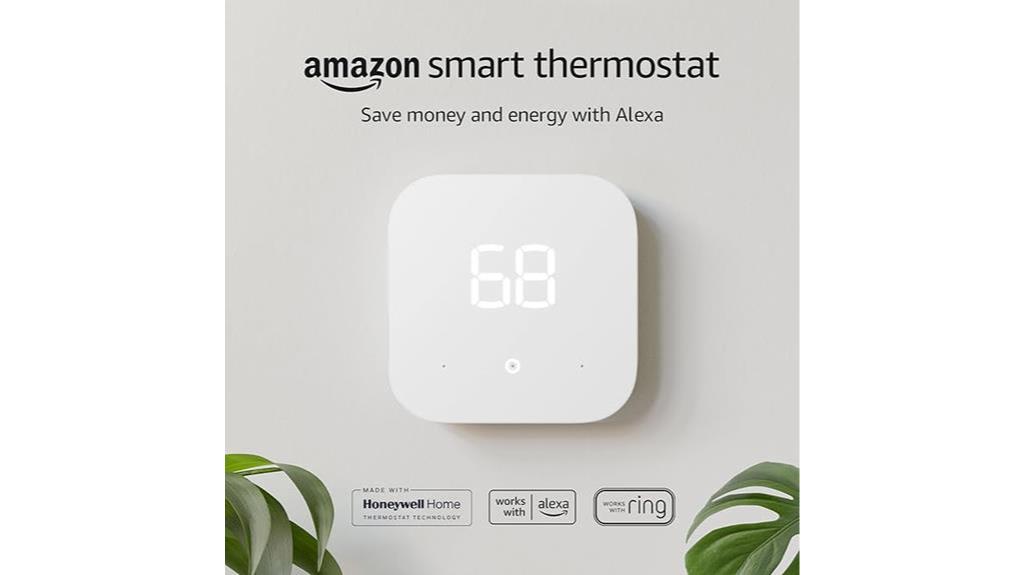
Looking to upgrade your home's heating and cooling efficiency? The Amazon Smart Thermostat is a fantastic choice, especially if you already use Alexa or Ring. This ENERGY STAR certified device can save you around $50 annually on energy bills. It supports Echo devices as temperature sensors, helping you find hot or cold spots in your home. With automatic control, Alexa adjusts the temperature based on your activities, ensuring comfort when you're home and saving energy when you're away. You can easily control it via the Alexa app or voice commands. Installation is straightforward, requiring a C-wire, and the guided setup makes it user-friendly. Enjoy reliable performance backed by Honeywell technology while managing energy usage efficiently!
Best For: Homeowners looking for an energy-efficient thermostat that integrates seamlessly with Alexa and Ring devices.
Pros:
- ENERGY STAR certified, helping to save approximately $50 on energy bills annually.
- Automatic temperature control adjusts based on user activities, enhancing comfort and efficiency.
- User-friendly installation with guided setup through the Alexa app.
Cons:
- Requires a C-wire for installation, which may not be available in older homes.
- Some users report cumbersome app navigation and limited scheduling options.
- Mixed feedback on the hunch functionality, with some finding it less effective.
Google Nest Learning Thermostat (3rd Generation)
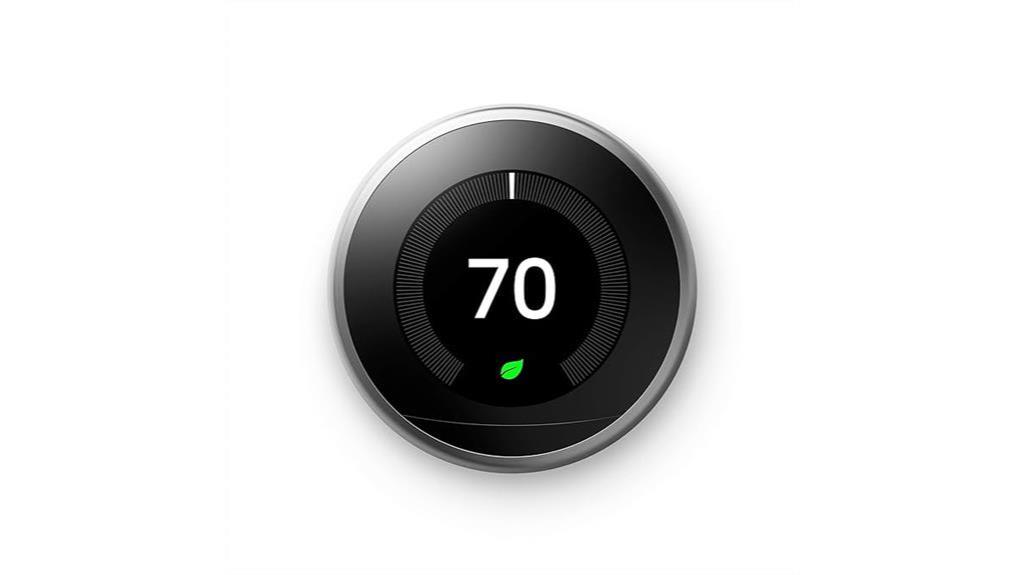
For homeowners seeking energy efficiency and convenience, the Google Nest Learning Thermostat (3rd Generation) stands out with its Auto-Schedule feature. It learns your habits and adjusts the temperature accordingly, ensuring comfort without constant manual input. With Home/Away Assist, the thermostat optimizes settings when you're not home, saving you energy. You can manage everything remotely through the Nest app, giving you control from anywhere. Plus, the Energy Monitoring feature allows you to track your usage and receive monthly insights. Installation is a breeze, requiring no complicated wiring or screws, although a C wire is needed for power. Users report significant savings on their energy bills, making this thermostat not just smart, but a smart investment.
Best For: Homeowners who prioritize energy efficiency and desire a convenient, smart solution for temperature control.
Pros:
- Auto-Schedule feature learns user habits, ensuring optimal comfort without manual adjustments.
- Easy installation process with user-friendly design, requiring no complicated wiring.
- Significant energy savings reported by users, leading to lower utility bills over time.
Cons:
- Requires a C wire for power, which may necessitate additional installation considerations.
- Some users have experienced initial bugs that need troubleshooting, such as rebooting.
- Occasional issues with temperature display and Away function, requiring adjustments for optimal performance.
Google Nest Thermostat – Smart Programmable Wifi Thermostat
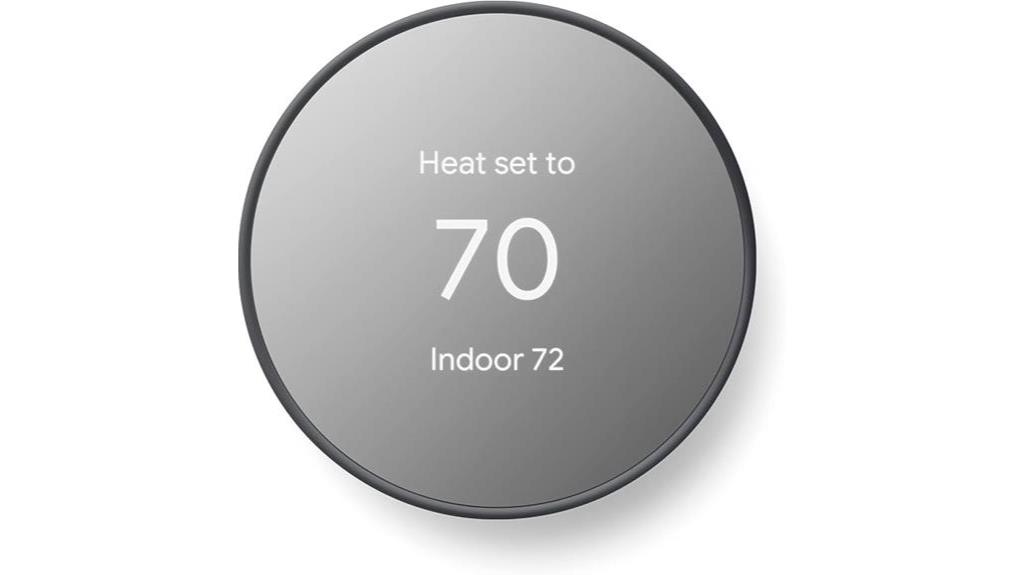
Engineered for energy-conscious homeowners, the Google Nest Thermostat offers a seamless blend of smart technology and user-friendly design. This ENERGY STAR certified device connects via Wi-Fi and allows you to manage your home's temperature remotely using the Google Home app. You can easily set energy-efficient schedules and receive alerts about HVAC issues, ensuring your system runs smoothly.
Installation is straightforward for most homes, although some may require a C wire. Users appreciate the thermostat's automatic adjustments when the house is empty, maximizing energy savings. While some report minor connectivity issues, the overall design and functionality make this thermostat a reliable choice. Just be sure to check compatibility before purchasing to avoid potential installation hiccups.
Best For: Energy-conscious homeowners looking for a smart, programmable thermostat that can be managed remotely.
Pros:
- ENERGY STAR certified for energy savings and comfort.
- Remote control and scheduling via the user-friendly Google Home app.
- Automatic adjustments optimize energy use when the home is empty.
Cons:
- Installation may require additional wiring or adapters, particularly for C wire compatibility.
- Some users experience connectivity issues, affecting performance.
- Limited support for certain HVAC configurations, such as 2-stage heating and cooling.
ecobee3 Lite Smart Thermostat – Programmable Wifi Thermostat
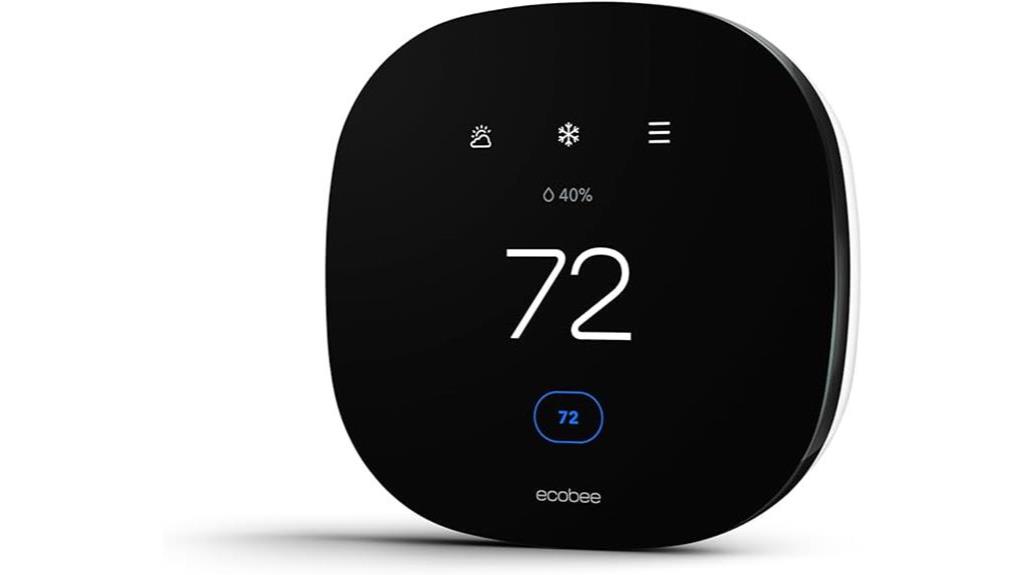
The ecobee3 Lite Smart Thermostat stands out as an ideal choice for homeowners seeking a blend of efficiency and convenience. With its Energy Star certification, you can save up to 23% on heating and cooling costs, making it a smart investment. It works seamlessly with Siri, Alexa, and Google Assistant, allowing you to control your home's temperature from anywhere using your smartphone. Installation is straightforward, especially with the included Power Extender Kit, perfect for homes without a C-wire. The sleek touchscreen interface and user-friendly app enhance your experience, while smart features, like pausing heating when a door's left open, keep your energy use in check. Just remember, external sensors are sold in two-packs, which might be a bit pricey.
Best For: Homeowners looking for an energy-efficient, smart thermostat that offers easy installation and integration with voice assistants.
Pros:
- Energy Star certified, saving up to 23% on heating and cooling costs.
- User-friendly touchscreen interface and mobile app for remote temperature control.
- Compatible with major smart home systems, enhancing overall home automation.
Cons:
- External sensors are sold in expensive two-packs, increasing overall cost.
- Power Extender Kit may limit functionality if not installed correctly.
- Programming multiple settings can be complex for some users.
Factors to Consider When Choosing a Smart Thermostat
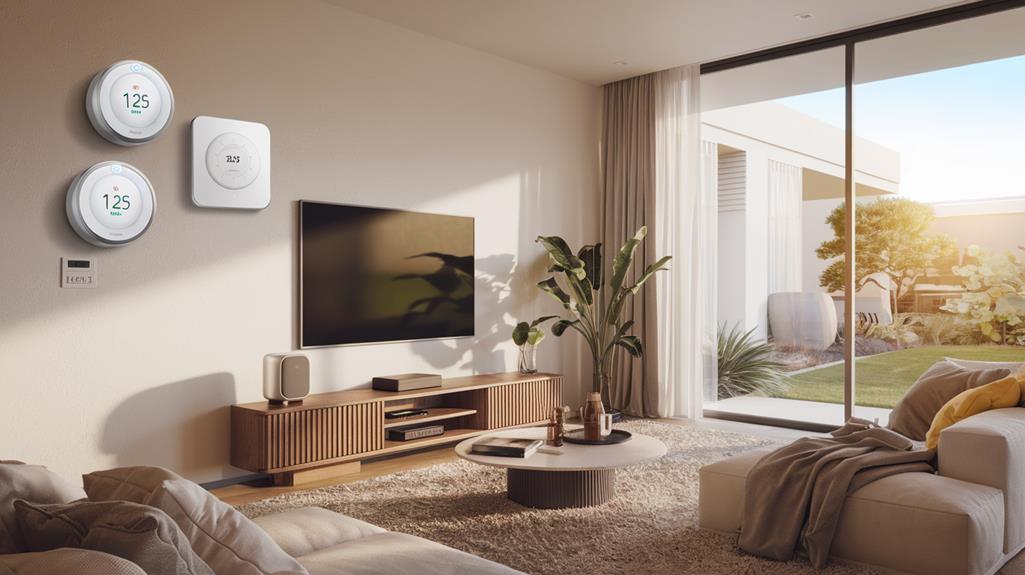
When you're choosing a smart thermostat, it's essential to take into account several factors that can impact your decision. Think about the installation requirements, energy efficiency ratings, and how compatible the thermostat is with your current systems. Also, evaluate the control options and app functionality to guarantee it meets your needs.
Installation Requirements
Before diving into the world of smart thermostats, it's crucial to take into account several installation requirements that can greatly impact your choice. First, check if your home has a common wire (C-wire) available, as many smart thermostats rely on it for power. Some models can function without a C-wire in specific setups, but it's wise to understand your wiring options.
Next, consider the installation process. Some thermostats are designed for DIY installation, providing step-by-step guides, while others may require professional help, especially with complex HVAC systems. Make sure the smart thermostat you choose is compatible with your existing heating and cooling systems.
Don't forget about the tools you'll need. Basic models might just require a screwdriver, but others could need specialized equipment for proper mounting or wiring. Finally, familiarize yourself with your current wiring setup. Taking pictures of your existing connections can simplify the installation and assist you in troubleshooting down the line. By keeping these requirements in mind, you'll be better prepared to make the right choice for your smart thermostat upgrade.
Energy Efficiency Ratings
Choosing a smart thermostat involves not just understanding installation requirements but also considering how energy efficiency ratings can affect your long-term savings. Look for ENERGY STAR certification, which indicates that the thermostat can help save energy and reduce your utility bills—averaging about $50 in annual savings.
Advanced features like geofencing, auto-scheduling, and smart maintenance greatly enhance energy efficiency by adapting to your behavior and optimizing HVAC usage. In fact, smart thermostats can save you up to 23% on heating and cooling costs compared to traditional thermostats set at a constant temperature.
Energy monitoring capabilities are another must-have, as they allow you to track consumption patterns and receive alerts for maintenance, contributing to long-term energy savings. Additionally, consider how the design and technology impact efficiency. Models that learn your habits and adjust settings automatically tend to outperform basic programmable models.
Compatibility With Systems
Compatibility with your existing HVAC system is vital for a successful smart thermostat installation. Before purchasing, confirm the thermostat you choose works with your system, whether it's conventional forced air, heat pumps, or radiant boilers. Some smart thermostats require a common wire (C-wire) for power, while others can operate without it. It's important to check your home's wiring to avoid installation headaches.
You can often conduct compatibility checks using online tools provided by thermostat manufacturers, allowing you to confirm if your system meets their requirements. Pay special attention if you have high-voltage systems, like electric baseboard heating, as many smart thermostats won't work with these setups. Understanding your system's specifications is key to making the right choice.
Additionally, consider how your new thermostat integrates with popular smart home systems. Many modern options offer enhanced functionality and ease of use when managing your home's climate control. So, before you explore the features and benefits of a smart thermostat, verify it's compatible with your current HVAC setup to enjoy a seamless and efficient experience.
Control Options Available
Understanding your HVAC system's compatibility sets the stage for exploring the control options available with smart thermostats. These devices typically offer multiple ways to control your home's temperature, enhancing your convenience and comfort. You can manage your thermostat through mobile apps, voice commands, or on-device buttons, depending on your preferences.
Many smart thermostats work seamlessly with popular voice assistants like Alexa and Google Assistant, enabling you to adjust the temperature hands-free. Imagine just saying, "Set the living room to 72 degrees," and your thermostat responds without you lifting a finger.
Advanced features like geofencing can automatically adjust settings based on your location, ensuring you're not wasting energy when you're away. User-friendly apps often provide detailed scheduling options, energy monitoring, and remote access, allowing you to manage settings from anywhere.
For added security, some models let you lock the wall display settings, so adjustments can only be made through the app. This prevents unauthorized changes and gives you peace of mind. Overall, considering the control options available is essential in selecting a smart thermostat that fits your lifestyle and enhances your energy efficiency.
App Functionality Features
When it comes to selecting a smart thermostat, app functionality features play an essential role in your overall experience. A user-friendly mobile app is critical for setup, scheduling, and monitoring usage, allowing you to adjust temperatures and access energy usage reports effortlessly. Look for apps that offer advanced features like geofencing, which automatically adjusts your home's temperature based on your location, and humidity control for added comfort.
Ease of installation is another important aspect; some apps let you take pictures of wiring connections to guide you through the setup process, making it less intimidating. You'll want responsive app functionality, too; ideally, changes should occur in real-time with minimal delays—1 to 2 seconds is perfect for temperature adjustments.
Security features enhance your control as well; certain apps allow you to lock wall display settings, ensuring that only app-based adjustments can be made. This adds an extra layer of security while giving you full control over your home's climate. By prioritizing these app functionality features, you can maximize both comfort and energy efficiency in your home.
Frequently Asked Questions
Can I Control These Thermostats Remotely via a Smartphone App?
Yes, you can control smart thermostats remotely via a smartphone app. This feature allows you to adjust your home's temperature from anywhere, whether you're at work or on vacation. You'll be able to set schedules, monitor energy usage, and receive alerts about temperature changes. Just make sure to download the app specific to your thermostat model, and you'll have complete control right at your fingertips. Enjoy the convenience and energy savings!
Are These Thermostats Compatible With All HVAC Systems?
Not all smart thermostats are compatible with every HVAC system. Before you buy one, check its specifications to verify it works with your setup. Most models support common systems like central heating and cooling, but some might not support specific types, such as heat pumps or multi-stage systems. You should consult the manufacturer's compatibility list or contact customer support to confirm it'll work seamlessly with your HVAC system.
How Easy Is the Installation Process for Each Thermostat?
Installing a smart thermostat is like planting seeds for a greener future. You'll find the process straightforward, often requiring just a screwdriver and a few minutes of your time. Most models come with step-by-step guides or apps to walk you through it. If you're comfortable with wiring, you won't face many hurdles. Just remember to turn off the power before you begin, and you'll be well on your way to smarter climate control!
Do Smart Thermostats Work With Solar Energy Systems?
Yes, smart thermostats can work with solar energy systems! They're designed to optimize your energy use, helping you take full advantage of your solar power. When paired with a solar system, these thermostats can adjust your heating and cooling based on the energy your panels generate. This not only enhances energy efficiency but also maximizes your savings on utility bills. Just ascertain the thermostat you choose is compatible with your specific solar setup.
What Warranty Options Are Available for These Smart Thermostats?
When considering warranty options for smart thermostats, you'll typically find a variety of choices. Most manufacturers offer at least a one-year warranty, covering defects in materials and workmanship. Some brands extend warranties up to five years or more, especially for higher-end models. Always check the specifics, as some warranties may include additional coverage for parts or labor. This can provide peace of mind and protect your investment in smart home technology.
Conclusion
In a world where comfort meets innovation, choosing the right smart thermostat can transform your home. With options like the Sensi and Google Nest, you can easily enhance energy efficiency while enjoying the convenience of modern technology. So, as you weigh your options, remember: the right thermostat isn't just a gadget; it's a step towards a smarter, more sustainable future. Why settle for ordinary when extraordinary is just a click away? Embrace the change and feel the difference!

